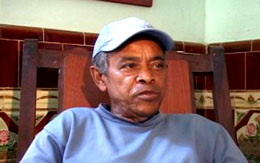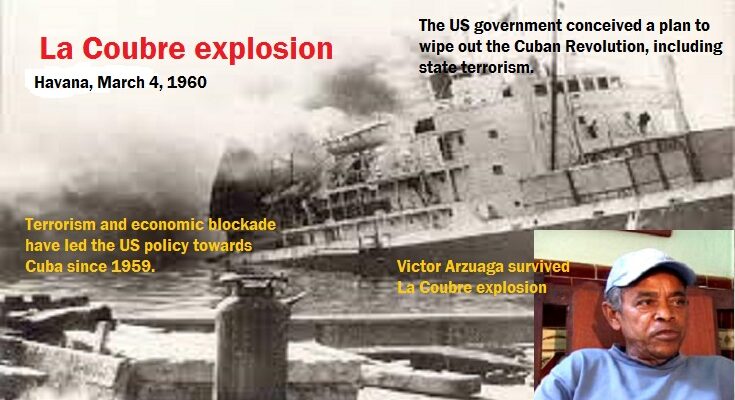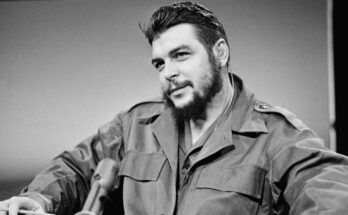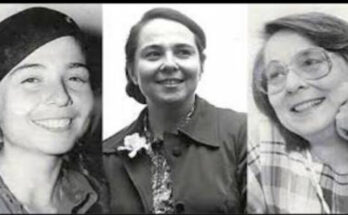Today we remember a sad and heartbreaking terrorist act carried out by the United States government against the Cuban people on March 4, 1960: the blowing up of the ship La Coubre in the Havana harbor, which caused the death of seventy people and more than two hundred wounded. One of the surviving victims is still alive in Contramaestre, municipality of Santiago de Cuba, Victor Arzuaga Rodriguez.

Throughout the 65 years of the revolution, the U.S. government has not ceased in its efforts to destroy the socialist development project chosen by the Cuban people, and terrorism has been a permanent instrument of its foreign policy against Cuba.
The modalities employed have been basically: sabotage or destruction of civilian targets within the country; pirate attacks against coastal installations and against merchant ships and fishing boats; attacks against Cuban facilities and personnel abroad, including diplomatic headquarters, aviation offices and aircrafts; the constant instigation of subversive elements, through radio and television stations, to carry out acts of this nature against the centers of production and services of the Cuban economy; the constant instigation of subversive elements, through radio and television stations, to carry out acts of this nature against the centers of production and services of the Cuban economy.
Another repugnant terrorist act perpetrated on April 13, 1961, with the help of counterrevolutionaries inside the country, was the setting fire to El Encanto, the largest department store in the country, located in the very center of Havana.
This fire caused the death of the worker Fe del Valle, the total destruction of the building and endangered a great number of Cuban homes. Those were the days prior to the mercenary invasion of the Bay of Pigs, which was defeated in less than 72 hours on the sands of Playa Giron.
In an attempt to derail the 1961 Literacy Campaign, counterrevolutionary gangs assassinated teachers Conrado Benitez, Manuel Ascunce and other Cuban children, youth and peasants.
Many documents declassified today demonstrate the historical link between the U.S. Government and the gangs that operated inside our country. In October 1961, CIA Inspector General Lyman Kirkpatrick presented a secret report referring to a covert action, known as Operation Silence, in which, by order of the US government, the CIA carried out 12 operations to supply weapons, ammunition and explosives to the armed gangs operating in our country.
In the same document, and in reference to the enormous center established by the CIA in Florida to carry out covert activities against Cuba, Kirkpatrick acknowledged that from January 1960, when it had 40 people, the Bureau expanded to 588 by April 16, 1961, becoming one of the largest in the clandestine services.
As an example, we will cite what happened on March 27, 1966. A terrorist, using a firearm, tried to divert to the United States, where they were always received as heroes, an IL-18 airplane of the Cubana de Aviación company, with 97 people on board, including 14 children. When he failed in his attempt, due to the courageous and determined conduct of the captain, who refused to divert the aircraft and landed at Havana International Airport, the hijacker killed the pilot and the custodian and seriously wounded the co-pilot.
On October 12, 1971, there was a vicious attack against the town of Boca de Samá, on the northern coast of the former Oriente province. This cowardly action against a small Cuban village caused two deaths and wounded other residents of the village, including two children.
On October 4, 1973, the Cuban fishing boats Cayo Largo 17 and Cayo Largo 34 were attacked by two gunboats manned by terrorists, who murdered fisherman Roberto Torna Mirabal and abandoned the rest of the crew in rubber rafts without food and water. One of the most abominable terrorist acts perpetrated against Cuba was the mid-flight explosion of a Cubana de Aviación airliner on October 6, 1976, with 73 people on board, including 57 Cubans, 11 young Guyanese (6 of them selected to study medicine in Cuba) and 5 citizens of the DPRK.
The attack against the Cuban civilian airliner was committed by two mercenaries of Venezuelan nationality, hired by two of the most notorious terrorists of Cuban origin: Orlando Bosch Avila (author of 321 terrorist acts), who, despite the contrary opinion of the Justice Department, received special authorization from President Bush Sr. to reside in the United States and has lived in Miami since 1990; and Luis Posada Carriles, currently imprisoned in Panama for attempting to assassinate the Cuban Head of State. Both had been recruited by the CIA since 1960 and had specialized in sophisticated sabotage techniques using all kinds of means. The two aforementioned terrorists were then members of the CORU organization, founded in June 1976 by Orlando Bosch himself, unifying several terrorist organizations. CORU considerably increased its terrorist actions not only against Cuba, but also against 24 other countries in Europe, Latin America and Central America.
In the United States itself, Cuban diplomat Felix Garcia was assassinated on September 11, 1980, after commemorating, together with several Chilean colleagues, the resistance of President Salvador Allende to the coup d’état carried out by Augusto Pinochet in collusion with the US government, the terrorist who shot him was Eduardo Arocena, leader of the Cuban-American ultra-right-wing organization Omega 7, which for years operated in the US with total impunity.
The Center for Historical Research on State Security (CIHSE) has documented 581 aggressions against Cuban representations abroad, a figure that is represented in the CIA Room within the Memorial of the Denunciation, and which in recent years has been surpassed with new events, such as the one that occurred last April 30, 2020 against the Embassy of our country in Washington.
In May 1981, the dengue virus was introduced in Cuba. In a few weeks, an epidemic of a disease that had never existed in the country was unleashed, reaching the unprecedented figure of 344,203 people infected. A total of 158 people died as a result of the epidemic, including 101 children.
The investigations and the meticulous studies carried out showed that the epidemic was deliberately introduced into Cuban territory by terrorist agents in the service of the United States Government. According to statements made by the American expert, Colonel Phillip Russell, during the XIV International Congress of the Pacific Ocean, American specialists in biological warfare had been the only ones to obtain a variety of the Aedes Aegypti mosquito sensibly associated with the transmission of the Dengue-2 virus.
In the trial held in 1984 in the United States against Eduardo Arocena, leader of the terrorist organization Omega 7, he confessed to having introduced germs into Cuba and acknowledged that the Dengue Hemorrhagic virus was introduced into the island by groups based in the United States.
The Cuban American National Foundation (CANF), financier of political campaigns of several legislators and even U.S. presidents, assumed the organization and financing of terrorist actions against Cuba since 1992. At the service, under the orders and with the money of the CANF, several terrorists were recruited in Central American countries, who placed bombs in Cuban tourist facilities for the payment of a reward. In 1997, they exploded seven bombs in hotels and tourist facilities in the country.
In one of these attacks, a young Italian tourist, Fabio Di Celmo, was killed.The objective was clear: to ruin Cuba’s tourism industry, which was already emerging as the country’s main economic sector.Terrorism against Cuba is not a thing of the past.On the contrary, the hateful and aggressive discourse of the current U.S. administration is a breeding ground for new terrorist actions, as shown by the strafing of the Cuban Embassy in Washington on April 30, 2020.




